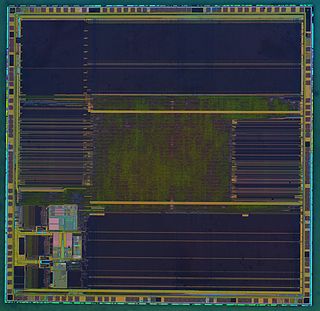
The Intel 8080 ("eighty-eighty") was the second 8-bit microprocessor designed and manufactured by Intel and was released in April 1974. It is an extended and enhanced variant of the earlier 8008 design, although without binary compatibility. The initial specified clock frequency limit was 2 MHz, and with common instructions using 4, 5, 7, 10, or 11 cycles this meant that it operated at a typical speed of a few hundred thousand instructions per second. A faster variant 8080A-1 became available later with clock frequency limit up to 3.125 MHz.

The 8086 is a 16-bit microprocessor chip designed by Intel between early 1976 and June 8, 1978, when it was released. The Intel 8088, released July 1, 1979, is a slightly modified chip with an external 8-bit data bus, and is notable as the processor used in the original IBM PC design, including the widespread version called IBM PC XT.

The Motorola 68000 is a 16/32-bit CISC microprocessor, which implements a 32-bit instruction set, with 32-bit registers and 32-bit internal data bus, but with a 16-bit data ALU and two 16-bit arithmetic ALUs and a 16-bit external data bus, designed and marketed by Motorola Semiconductor Products Sector. Introduced in 1979 with HMOS technology as the first member of the successful 32-bit Motorola 68000 series, it is generally software forward-compatible with the rest of the line despite being limited to a 16-bit wide external bus. After 39 years in production, the 68000 architecture is still in use.

The Motorola 6809 ("sixty-eight-oh-nine") is an 8-bit microprocessor CPU with some 16-bit features from Motorola. It was designed by Terry Ritter and Joel Boney and introduced in 1978. It was a major advance over both its predecessor, the Motorola 6800, and the related MOS Technology 6502. Among the systems to use the 6809 are the Dragon home computers, TRS-80 Color Computer, the Vectrex home console, and early 1980s arcade machines including Defender, Robotron: 2084, Joust, and Gyruss.

AVR is a family of microcontrollers developed since 1996 by Atmel, acquired by Microchip Technology in 2016. These are modified Harvard architecture 8-bit RISC single-chip microcontrollers. AVR was one of the first microcontroller families to use on-chip flash memory for program storage, as opposed to one-time programmable ROM, EPROM, or EEPROM used by other microcontrollers at the time.

The Intel 4040 microprocessor was the successor to the Intel 4004. It was introduced in 1974. The 4040 employed a 10 μm silicon gate enhancement load PMOS technology, was made up of 3,000 transistors and could execute approximately 62,000 instructions per second. General performance, bus layout and instruction set was identical to the 4004, with the main improvements being in the addition of extra lines and instructions to recognise and service interrupts and hardware Halt/Stop commands, an extended internal stack and general-purpose "Index" register space to handle nesting of several subroutines and/or interrupts, plus a doubling of program ROM address range.

The Freescale 683xx is a family of compatible microcontrollers that use a Motorola 68000-based CPU core. The family was designed using a hardware description language, making the parts synthesizable, and amenable to improved fabrication processes, such as die shrinks.

The MSP430 is a mixed-signal microcontroller family from Texas Instruments. Built around a 16-bit CPU, the MSP430 is designed for low cost and, specifically, low power consumption embedded applications.
The RS08 core is a reduced-resource version of the Freescale MC68HCS08 central processing unit (CPU), a member of the 6800 microprocessor family. It has been implemented in several microcontroller devices for embedded systems.

The Parallax P8X32A Propeller is a multi-core processor parallel computer architecture microcontroller chip with eight 32-bit reduced instruction set computer (RISC) central processing unit (CPU) cores. Introduced in 2006, it is designed and sold by Parallax, Inc.
The 68HC08 is a broad family of 8-bit microcontrollers from Freescale Semiconductor.
The 9S08 is a 8-bit microcontroller (µC) family originally produced by Motorola, later by Freescale Semiconductor, and currently by NXP, descended from the Motorola 6800 microprocessor. It is a CISC microcontroller. A slightly extended variant of the 68HC08, it shares upward compatibility with the aging 68HC05 microcontrollers, and is found in almost any type of embedded systems. The larger members offer up to 128 KiB of flash, and 8 KiB of RAM via a simple MMU which allows bank-switching 16 KiB of the address space and an address/data register pair which allows data fetches from any address. The paging scheme used allows for a theoretical maximum of 4MB of flash.

STM32 is a family of 32-bit microcontroller integrated circuits by STMicroelectronics. The STM32 chips are grouped into related series that are based around the same 32-bit ARM processor core, such as the Cortex-M7F, Cortex-M4F, Cortex-M3, Cortex-M0+, or Cortex-M0. Internally, each microcontroller consists of the processor core, static RAM, flash memory, debugging interface, and various peripherals.

LPC is a family of 32-bit microcontroller integrated circuits by NXP Semiconductors. The LPC chips are grouped into related series that are based around the same 32-bit ARM processor core, such as the Cortex-M4F, Cortex-M3, Cortex-M0+, or Cortex-M0. Internally, each microcontroller consists of the processor core, static RAM memory, flash memory, debugging interface, and various peripherals. The earliest LPC series were based on the Intel 8-bit 80C51 core. As of February 2011, NXP had shipped over one billion ARM processor-based chips.
UDOO is a single-board computer with an integrated Arduino Due compatible microcontroller, designed for computer science education, the world of Makers and the Internet of Things.

















